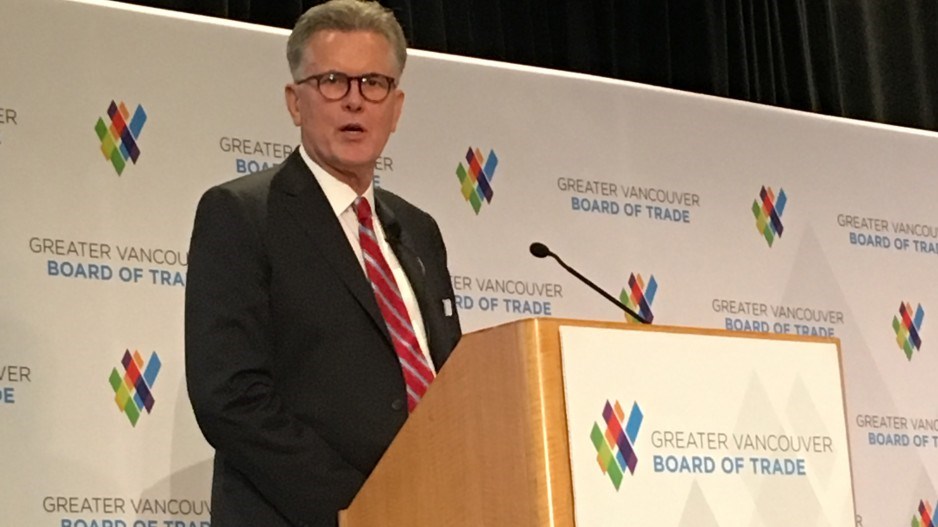A global glut of liquefied natural gas that was expected to delay large LNG projects might have been overstated, according to Royal Dutch Shell , and prospects for an LNG industry in B.C. might not be over, after all, according to the CEO of LNG Canada.
But before companies like Shell – one of the key partners in the LNG Canada consortium – pull the trigger on a $40 billion commitment, it needs Victoria to rethink the way the industry would be taxed – something Michelle Mungall, the BC NDP’s new minister of energy, mines and petroleum resources, seems open to considering.
“We do need to address, on a broader scale, what’s going on in terms of the global marketplace and [the question]: is B.C. competitive in this global marketplace as it stands right now?” Mungall said.
“And that’s a very good question and one that we’re answering. I’ve directed my ministry to look into that and to begin to work with First Nations, local communities, as well as the industry.”
She made the comments September 22, following an address to the Greater Vancouver Board of Trade (GVBOT) by Andy Calitz, CEO of LNG Canada, whose partners include Shell, Mitsubishi (Nasdaq:MSBHF), PetroChina and Korea Gas Corp.
Following recent announcements by Petronas and Nexen that they were pulling the plug on multibillion-dollar LNG projects, even LNG industry cheerleaders expressed concern that B.C. had “missed the boat.”
“I don’t believe that Canada has missed that boat,” Calitz told GVBOT members.
“I believe that B.C. will have an LNG industry, that there is societal support for an LNG industry from B.C., and … I believe specifically the LNG project can and will happen in B.C.,” Calitz later told Business in Vancouver.
Most oil and gas analysts have predicted that new supplies of LNG from Australia and, more recently, the U.S., would create an oversupply that would not balance out with growing demand until around 2024 or 2025.
That would mean that no final investment decisions on large LNG projects anywhere in the world would likely made before 2019.
But Calitz said LNG Canada will be submitting a “decision support package” to the four consortium partners in 2018, and some analysts are now adjusting their LNG windows.
Stream Asset Financial Management, which until recently had been pessimistic about new LNG projects, has recently become more bullish, thanks to a “massive surge” in natural gas demand. Stream Asset now believes the next demand window could open as early as 2020.
In a recent brief, it cites spot prices in Japan that indicate “the market is absorbing all new LNG supply.” Moreover, China announced this summer that it plans to increase natural gas to 10% of its total energy mix by 2020 and 15% by 2030.
“This is a game-changer to global natural gas markets and, by itself, can bring LNG to undersupply two to three years earlier than expected,” Stream Asset said in a brief last week.
Three weeks ago, Shell’s integrated gas and new energies director, Maarten Wetselaar, told Bloomberg that the LNG oversupply that was expected, especially from Australia, hasn’t materialized.
“Every LNG cargo that could technically be produced in this world has been produced and has found a well-paying customer,” he told Bloomberg. “So this market is in more balance than people perhaps perceive.”
That might explain why Calitz thinks B.C. still has a chance of developing an LNG industry. He reiterated B.C.’s two main advantages: an abundance of cheap natural gas and proximity to Asian markets.
Unlike Petronas’ Pacific NorthWest LNG project, the LNG Canada plant in Kitimat and associated pipeline are already permitted and have the support of local First Nations, notably the Haisla.
But Shell has large LNG projects proposed in almost every time zone, and the company has stated that it will invest only in projects with the best economics.
Calitz said the biggest hurdle for LNG Canada is tax competitiveness. He said B.C.’s carbon tax, which is being raised to $35 per tonne in April 2018 from $30 per tonne, is not his biggest concern.
“There should be a tax on carbon,” Calitz said. “It’s not the first increment of $5 per tonne that scares me, but somehow we need an indication from the government as to where that will go.
“We need the government of British Columbia specifically, but also the federal government, to take a last look at the fiscal tax competitiveness of Canada for an LNG project.”
One of analysts’ biggest concerns was a special 3.5% tax on LNG production that was introduced by the previous BC Liberal government. Australia is the only other major LNG-producing nation that has a similar tax. On the other hand, Australia no longer has a carbon tax.
Asked if LNG Canada wants B.C.’s LNG tax reviewed, Calitz suggested it does.
“That is a subject we are discussing with the government,” he said.
Because of its vocal opposition to Petronas’ Pacific NorthWest LNG project, the new NDP government has been viewed as being lukewarm at best, and hostile at worst, toward the LNG industry.
Mungall attempted to dispel that notion by saying PacificNorthWest LNG was a special case. It had chosen a site – Lelu Island – that was environmentally problematic.
“Our position has always been supportive of LNG, as long as the industry meets our four conditions,” Mungall said. “Conditions are not roadblocks; they are road maps.”
She added there is generally support for an LNG industry in B.C., including among First Nations.
“They want to see this go forward because they see the economic development opportunity for their community.”




